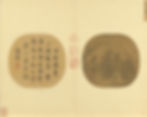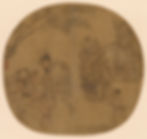Knickknack Peddlers by Li Song 李嵩 (fl. 1190-1230)
- Rachelle
- Nov 15, 2021
- 3 min read

“Shidan yingxi” 市擔嬰戲 by Li Song 李嵩 (fl. 1190-1230)
Picture credit: The National Palace Museum, Taipei
Inscription by the Qianlong Emperor 乾隆 (1711-1799, ruling 1735-1796)
百物擔来一擔強,
羣嬰争取價無償。
貨郎爾亦知之否,
原爾自家閒惹忙。[1]
A hundred objects are brought over, more than what a shoulder pole [could bear].
In the tumult of children, the prices are not paid.
Peddler, you do know that, don’t you?
It is you who has nothing better to do than bring this chaos.

Detail of the “Huolang tu” 貨郎圖 (Knickknack Peddler) by Li Song
Screenshot of the high-quality digitalisation on the website of the Palace Museum, Beijing
肩挑重擔那辭疲,
奪攘兒童勞護持。
莫笑貨郎癡已甚,
世人誰不似其癡。
Heavy weights on the shoulders, [he] doesn’t mind the burden.
With children surging forward, [he] struggles to maintain order.
Don’t mock the peddler for being too silly –
Who in this world is not as silly as him?
癸巳仲春下澣御題
Inscribed by the imperial hand in the last decade of the mid-spring [month] of the guisi year [1773]
Notes:
The knickknack peddler is an important theme in Chinese genre paintings that became especially popular during the Ming dynasty (1368-1644) in representations of festive scenes. As the earliest examples of this motif, the four paintings of knickknack peddlers attributed to Li Song are widely believed to be realistic representations of knickknack peddlers in folk culture in contrast to the more extravagantly dressed peddlers in Ming dynasty works, who mostly serve as a festive symbol. Before being adopted by a court painter, Li Song had spent years as a carpenter, which is considered one of the reasons why he can depict folk topics in such minute details. The high-resolution images available freely on museum websites offer a great opportunity to appreciate the delicate depiction, especially for the three smaller works (less than 30 x 30 cm) mounted as album leaves.
However, the “realism” in Li Song’s works is not as apparently justifiable as it seems. Huang Xiaofeng 黃小峰, who examines the practicability of the mobile stall and compares contemporary and later representations of the knickknack peddler, suggests that Li Song’s works are not exactly realistic depiction of commoners’ real life. With reference to textual documentation of festive customs during the Song dynasty (960-1279) and the Ming dynasty, Huang Xiaofeng argues that Li Song’s works, in a similar manner to the Ming works, were created in the imperial court for the Lantern Festival in spring, and the knickknack peddlers are not real peddlers but actors who play the role of peddlers on this festive occasion.[2]
[1] Red characters rhyme. [2] See Huang Xiaofeng 黄小峰, “Leshi huan tong wanzhong xin Huolang tu jiedu” 樂事還同萬眾心——《貨郎圖》解讀, Gugong bowuyuan yuankan 故宮博物院院刊 2007 (02): 103-117+158; available at https://www.dpm.org.cn/paints/talk/207744.html.

“Yinxi huolang tu” 嬰戲貨郎圖 by Li Song
Picture credit: The Cleveland Museum of Art (https://www.clevelandart.org/art/1963.582)

“Knickknack Peddler”, anonymous (widely attributed to Li Song)
Picture credit: The Metropolitan Museum of Art
Copyright Declaration*:
The texts and images used on the website of Rachelle's Lab are either from the public domain (e.g. Wikipedia), databases with open data licences (e.g. Shuhua diancang ziliao jiansuo xitong 書畫典藏資料檢索系統, National Palace Museum, Taipei), online libraries that permit reasonable use (e.g. ctext.org), or original work created for this website.
Although fair use of the website for private non-profit purposes is permitted, please note that the website of Rachelle's Lab and its content (including but not limited to translations, blog posts, images, videos, etc.) are protected under international copyright law. If you want to republish, distribute, or make derivative work based on the website content, please contact me, the copyright owner, to get written permission first and make sure to link to the corresponding page when you use it.
版權聲明:
本站所使用的圖片,皆出自公有領域(如維基)、開放數據庫(如臺北故宮博物院書畫典藏資料檢索系統)、允許合理引用的在線圖書館(如中國哲學電子化計劃)及本人創作。本站允許對網站內容進行個人的、非營利性質的合理使用。但請注意,本站及其內容(包括但不限於翻譯、博文、圖像、視頻等)受國際版權法保護。如需基於博客內容進行出版、傳播、製作衍生作品等,請務必先徵求作者(本人)書面許可,并在使用時附上本站鏈接,註明出處。
*Read more about copyright and permission here.
